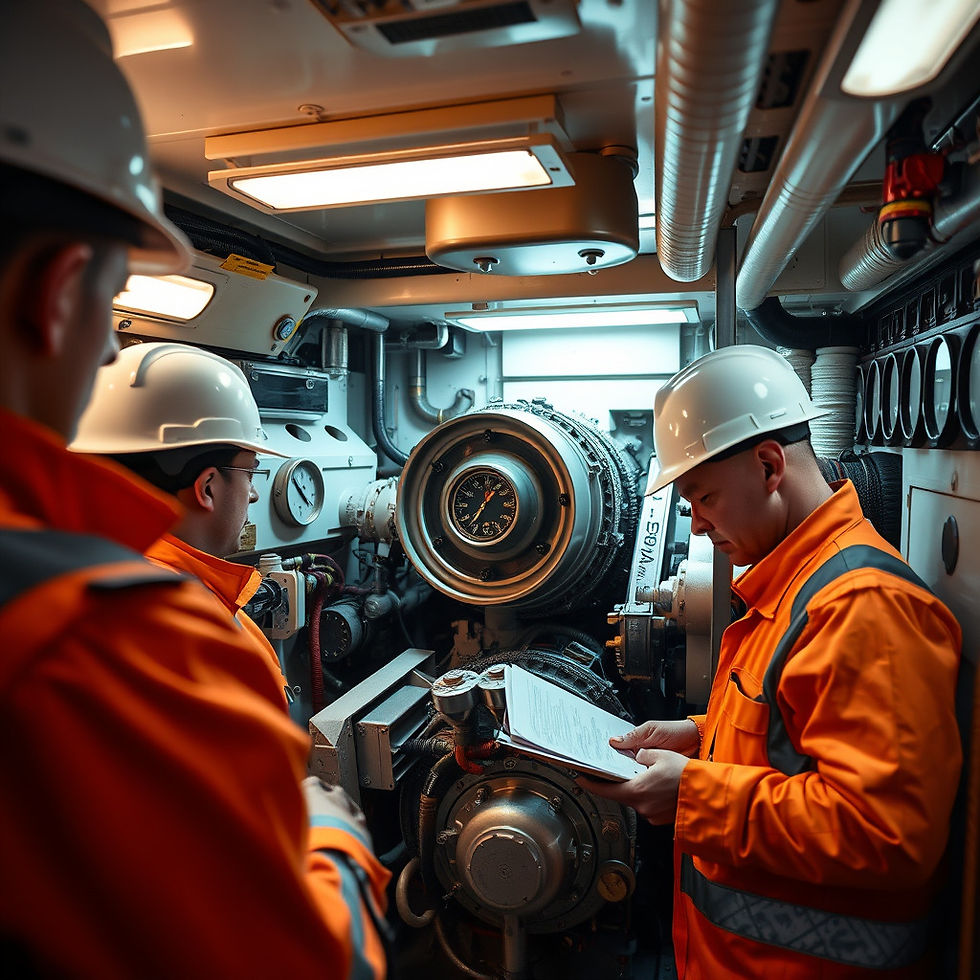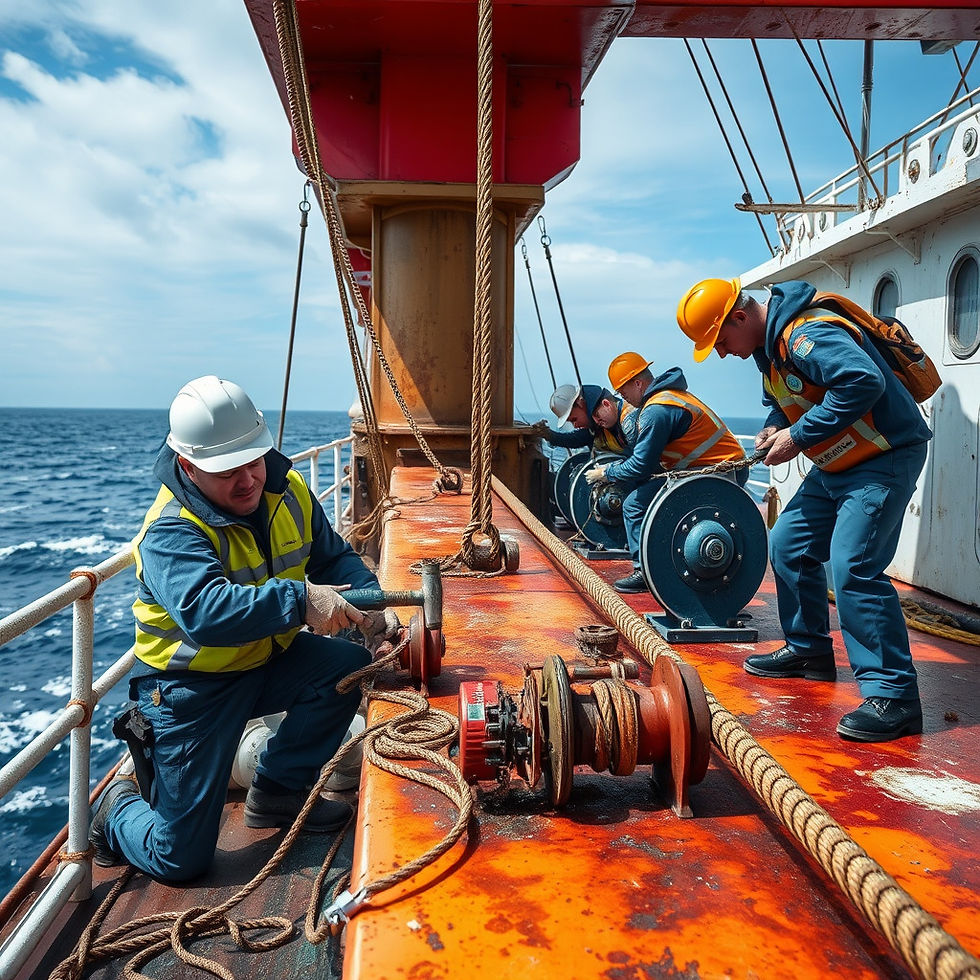🚢 Deck and Engine Room Maintenance: Routine Tasks and Procedures Onboard Ships
- kousik pattanayak

- Jun 16
- 6 min read
Updated: Aug 4
In the vast and challenging world of maritime operations, deck and engine room maintenance isn't just a chore – it's the absolute cornerstone of a vessel's safety, operational efficiency, and long-term viability. Whether you're a seasoned marine engineer, a diligent deck officer, or an aspiring seafarer charting your career path, a deep understanding of these routine procedures is absolutely essential for smooth and successful voyages in 2025 and beyond.

🔧 Why Ship Maintenance Matters at Sea (More Than Ever!)
A modern ship is a marvel of engineering, essentially a self-contained floating city. Every piece of its machinery, its vast structure, and intricate systems must function flawlessly, often in extreme conditions and complete isolation. Regular, meticulous maintenance isn't just about keeping things running; it's about a holistic approach to maritime excellence:
Operational Reliability: Prevents unexpected breakdowns, ensuring strict adherence to schedules and avoiding costly delays.
Crew Safety: Malfunctioning equipment is a major hazard. Proper maintenance directly contributes to a safer working environment for everyone onboard.
Regulatory Compliance: Meeting stringent international standards set by organizations like the IMO (International Maritime Organization), SOLAS (Safety of Life at Sea), and MARPOL (Marine Pollution) is non-negotiable. Non-compliance can lead to massive fines, detentions, and reputational damage.
Fuel Efficiency and Cost Savings: Well-maintained engines consume less fuel. Regular hull cleaning and propeller maintenance reduce drag, leading to significant operational cost reductions.
Vessel Longevity: Proper care extends the lifespan of the ship, protecting a massive capital investment.

⚙️ Engine Room Maintenance: From Daily Checks to Critical Periodic Tasks
The engine room is unequivocally the pulsating heart of the ship. It houses the powerful propulsion systems, vital generators, numerous pumps, compressors, and an array of auxiliary machinery that keeps the vessel alive. Here's a breakdown of how this critical space is meticulously kept in top shape:
🛠️ Daily Checks (The Sentinel's Watch)
These are performed diligently by watchkeeping engineers, ensuring everything is within operational parameters:
Oil & Fuel Levels: Routine checks and topping up of lubricating oil in the main engine, generators, and other auxiliary machinery. Fuel levels are also closely monitored.
Leak Detection: Thorough inspection for any signs of oil, fuel, or coolant leaks from pipelines, joints, and machinery. Early detection prevents major spills and malfunctions.
Control Panel Monitoring: Constant observation of critical readings such as temperature, pressure, and RPM for all running machinery. Any deviation signals a potential issue.
Bilge Water Levels: Ensuring that bilge wells are regularly checked and bilge pumps are operational to remove any accumulated water.
🔄 Weekly & Monthly Tasks (Proactive Care)
Beyond daily routines, these tasks delve deeper into the machinery's health:
Filter Cleaning/Replacement: Air, fuel, and lubricating oil filters are crucial for machinery longevity. They must be cleaned or replaced regularly to prevent contamination.
Battery Maintenance: Checking electrolyte levels, ensuring proper charge status, and cleaning terminals for all ship batteries, especially those for emergency systems.
Lubrication: Applying grease to bearings, gears, linkages, and all other moving parts to minimize friction and wear.
Ventilation Systems: Cleaning air ducts, checking exhaust fans, and ensuring proper airflow within the hot and humid engine room environment.
🔥 Safety Protocols (Non-Negotiable)
Safety in the engine room is paramount due to the presence of fuel, high temperatures, and rotating machinery.
Fire Detection & Suppression: Regular testing of fire alarms, smoke detectors, CO₂ fire suppression systems, and ensuring all portable fire extinguishers are readily accessible and charged.
Electrical Safety: Inspecting insulation, checking grounding, and verifying the functionality of emergency lighting and cut-off switches.
PPE Compliance: Strict enforcement of Personal Protective Equipment (PPE) usage, ensuring all crew members wear appropriate gloves, helmets, goggles, and ear protection when in the engine room.

⚓ Deck Maintenance: Keeping the Ship Seaworthy and Presentable
The deck department is responsible for the ship's structural integrity, cargo operations, and the maintenance of all external systems. This ensures the vessel remains seaworthy and aesthetically presentable.
🧹 Routine Deck Tasks (Battling the Elements)
The marine environment is harsh, making constant vigilance necessary:
Rust Removal & Painting: The relentless battle against corrosion. This involves using chipping hammers, grinders, and applying multiple coats of anti-corrosive paint and topcoats to protect the steel structure.
Mooring Equipment Check: Regular inspection of winches, ropes (mooring lines), and bollards for wear and tear. Proper lubrication of moving parts in winches is also vital.
Lifeboat & Davit Testing: Weekly checks of lifeboat engines and release mechanisms. Monthly lowering drills ensure that these critical life-saving appliances are always ready for deployment.
Navigation Lights & Signals: Verifying the functionality of all navigation lights (masthead, side, stern, anchor) and sound signaling devices (whistles, horns), replacing bulbs as needed.
🧼 Cleaning & Preservation (A Clean Ship is a Happy Ship)
Beyond basic cleanliness, these tasks are vital for long-term preservation:
Deck Washing: Regular washing down of the deck to remove corrosive salt deposits, dirt, and cargo residues.
Greasing Moving Parts: Lubricating the moving components of deck machinery like cranes, hatch covers, and windlasses to ensure smooth operation and prevent rust.
Sealant Application: Inspecting and reapplying sealants around hatch covers, doors, and various deck openings to prevent water ingress, which can damage cargo and internal structures.
🧠 Expert Advice: Best Practices for Shipboard Maintenance in 2025
Effective maintenance goes beyond just following a checklist. It requires foresight and dedication.
“Preventive maintenance is not just about fixing things after they break—it’s about predicting potential failures before they even happen. Proactive planning using modern PMS systems is the key to minimizing downtime and maximizing safety at sea.” — Chief Engineer R. Banerjee, 20+ years at sea
Key Tips for Superior Maintenance:
Strictly Follow the Planned Maintenance System (PMS) Schedule: Modern ships rely on digital PMS software. Adhere to every scheduled task, no matter how small.
Maintain Detailed Logbooks: Accurate and meticulous record-keeping of all inspections, repairs, and part replacements is vital for troubleshooting, regulatory compliance, and future planning.
Always Refer to Manufacturer Manuals: Specific machinery requires specific care. Always consult the original equipment manufacturer's (OEM) manuals for precise guidelines and recommended procedures.
Conduct Toolbox Meetings: Before commencing any major or potentially hazardous maintenance task, gather the team for a "toolbox meeting" to discuss the procedure, potential risks, and safety precautions. This ensures everyone is on the same page.
Embrace Technology: Utilize sensors, condition monitoring, and predictive analytics tools where available to anticipate machinery issues before they become critical.

🧭 How to Choose the Right Maintenance Equipment (and Recovery Tools)
When outfitting a ship's maintenance arsenal, or considering personal recovery tools, keep these points in mind:
Purpose: Differentiate between tools for the engine room (e.g., specialized wrenches, diagnostic tools) versus deck use (e.g., chipping hammers, painting equipment). For recovery, consider if it's for the cabin or common areas.
Durability: The marine environment demands materials that are corrosion-resistant and robust – always opt for marine-grade or industrial-strength equipment.
Portability: For hand tools or personal recovery items like massage cushions, portability is key for easy storage and use in confined spaces. Full massage chairs are for larger vessels or training centers.
Comfort: Especially for ergonomic chairs or recovery tools, comfort and support are paramount for the well-being of the crew during long watchkeeping hours or after strenuous tasks.
Reviews & Ratings: Always check verified user feedback and product ratings before making a purchase, whether it's a heavy-duty grinder or a massage chair.
📌 Conclusion
Whether you're maintaining a massive 200-meter tanker navigating the high seas or a bustling coastal cargo vessel, routine deck and engine room maintenance remains an absolutely non-negotiable aspect of maritime operations. It is the silent, often unsung, force that consistently keeps ships safe, supremely efficient, and fully compliant with all international regulations.
From the meticulous daily oil checks in the engine room to the strategic application of anti-corrosive paint on deck, every single detail matters. And equally important is ensuring the well-being of the dedicated crew. Equipping your mariners with the right tools for both their demanding tasks and their essential recovery – be it a robust wrench or a therapeutic acupressure massage chair for relaxation – is a crucial investment. Diligently follow all procedures, prioritize safety, and your ship will undoubtedly reward you with countless smooth voyages, minimal breakdowns, and optimal performance for years to come.
Liked this post? Share it with your fellow mariners, maritime professionals, and anyone interested in the backbone of shipping! Subscribe to our blog for more in-depth shipboard insights, essential gear reviews, and updates on the latest maritime technologies! ⚓📈
Comments